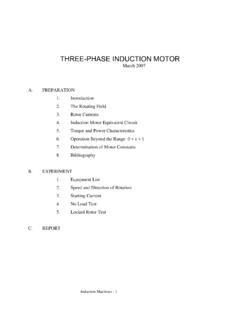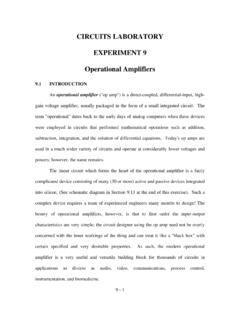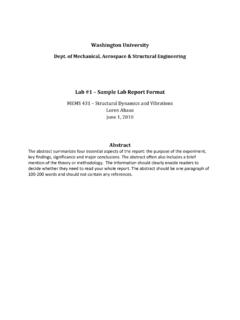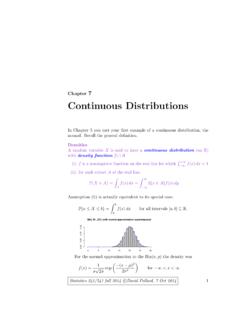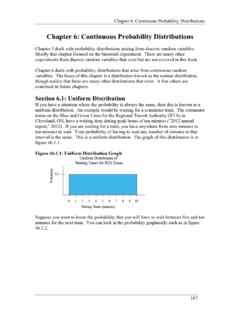Transcription of Chapter 6. Control Charts for Variables
1 Chapter 6. Control Charts for VariablesControl Charts for and xR: quantity of interest ( , )xxN 12,,: samples of , xNn Subgroup Data with Unknown and gp : grand average of , best estimate for xx 12,,: ranges of I Application of andRChartsxPhase I Application of and RCharts Equations 5-4 and 5-5 are trial Control Determined from minitial samples. Typically 20-25 subgroups of size nbetween 3 and 5. Any out-of- Control points should be examined for assignable ypgcauses. If assignable causes are found, discard points from calculations and revise the trial Control limits. Continue examination until all points plot in Control Continue examination until all points plot in Control . Adopt resulting trial Control limits for use. If no assignable cause is found, there are two point as if an assignable cause were found and revise point as if an assignable cause were found and revise Retain point and consider limits appropriate for Control .
2 If there are many out-of- Control points they should be examined for patterns that may identify underlying process 5-1 Assume spec tolerance is +/- probability:Nonconformance probability:Cp: Process Capability Ratio (PCR)Cp: Process Capability Ratio (PCR)Note: 6 spread is the basic definition of process capability. 3 above mean and 3 If is unknown, we can use =. in the example is 2dP: % of specification band the process uses upPcan be estimated as:P : % of specification band the process uses up. Pcan be estimated as:Revision of Control Limits and Center LinesRevision of Control Limits and Center Lines Effective use of Control Charts requires periodic review and revision of Control limits and center lines. Sometimes users replace the center line on the chart with a target When Rchart is out of Control , out-of- Control points are often eliminated to re-compute a revised value of which is used to determine new limits and center line on Rchart and new limits on II Operation of ChartsPhase II Operation of Charts Use of Control chart for monitoring future production, after a set of reliable limits are established, is called phase IIof Control chart usage (Figure 5-4).
3 A run chart showing individuals observations in each sample, called a tolerance chart or tier diagram (Figure 5-5), may reveal patterns or unusual observations in the vs. Specification LimitsControl vs. Specification Limits Control limits are derived from natural process variability, or the natural tolerance limits of a process. Specification limits are determined externally, for example by customers orexample by customers or designers. There is no mathematical or ttiti l lti hi btstatistical relationship between the Control limits and the specification SubgroupsRational Subgroups Charts monitor between-sample Rcharts measure within-sample variability. Standard deviation estimate of used to construct Control limits is calculated from within-sample variability. It is not correct to estimate usingGuidelines for Control chart DesignGuidelines for Control chart Design Control chart design requires specification of sample size, Control li iid hdliflimit width, and sampling frequency.
4 Exact solution requires detailed information on statistical characteristics as well as economic factors. The problem of choosing sample size and sampling frequency is one of The problem of choosing sample size and sampling frequency is one of allocating sampling effort. For chart , choose as small a sample size consistent with magnitude of process shift one is trying to detect. For moderate to xlarge shifts, relatively small samples are effective. For small shifts, larger samples are needed. For small samples, Rchart is relatively insensitive to changes in process standard deviation For larger samples (n> 10 or 12)sorprocess standard deviation. For larger samples (n> 10 or 12), sor s2charts are better choices. NOTE: Skip Section on Changing Sample Size (pages 209-212) NOTE: Skip Section on Changing Sample Size (pages 209-212) Charts Based on Standard ValuesD1=d2-3d3D1 d23d3D2 = d2+ 3d3d2 : mean of distribution of relative ranged3: standard deviation of distribution of relative rangeInterpretation of and ChartsxREffect of Nonnormality on and ChartsxR An assumption in performance properties is that the underlying diib iflihi i ildistribution of quality characteristic is normal .
5 If underlying distribution is not normal , sampling distributions can be derived and exact probability limits obtained. Usual normal theory Control limits are very robust to normality assumption. In most cases samples of size 4 or 5 are sufficient to ensureIn most cases, samples of size 4 or 5 are sufficient to ensure reasonable robustness to normality assumption for chart . Sampling distribution of Ris not symmetric, thus symmetric 3-sigma limits are an approximation and -risk is not Rchart is more xppsensitive to departures from normality than chart . Assumptions of normality and independence are not a primary concern in Phase Characteristic (OC) Function is known. In- Control mean: 0out of Control mean: 1= 0+ k Probability of not detecting shift: -riskLbf L: number of sForL = 3, n = 5, k = run length (r): shift is detected in the the number of samples for detecting shift = Run Length for ChartxFor Shewhart Control chart :Average time to signal (ATS)Average number of individual units sampled for detection (I) Control Charts for and xsUse the and Charts instead of the and Charts when:xsxR225446443 1 and 3 1 BccBcc= =+ Assume no standard is given for.
6 Need to estimate. preliminary samples, each of size . mn th: standard deviation for sampleisi4: unbiased estimator for Sc chart has the following parameters:s22344433 Note:11and11 Then:BcBc= =+ 344444 Note: 11 and 11 Then:BcBccc+Whenis used to estimatechart has the following parameters:Sx 4 When is used to estimate , chart has the following parameters:xc 343 Define . Then:Acn=Example 5-3 For chart :xFor chart :sand Control Charts with Variable SampleSizexs and Control Charts with Variable Sample SizexsExample 5-4 For chart :xFor chart :s2 Control ChartsCo t o C a tsSometimes it is desired to use s2chart over schart. 2 The parameters fors2chart are: Shewhart Control chart for Individual MeasurementsWhat if there is only one observation for each the moving range between two successive samples for 5-5 Use the d2, D3and D4values from n = 2 row for individual :Phase II Operation and Interpretation of ChartsshiftshiftshiftAverage Run LengthsAverage Run Lengths ARL0of combined individuals and moving-range chart with til 3iliitill hlthShhtconventional 3-sigma limits is generally much less than Shewhart Control chart .
7 Ability of individuals chart to detect small shifts is very of individuals chart to detect small shifts is very In- Control ARL is dramatically ffd bl daffected by nonnormal data. One approach for nonnormal data is to determine Control limits for individuals controllimits for individuals Control chart based on percentiles of correct underlying 5-6 Skip Section on More about Estimating (pages 239 242).


